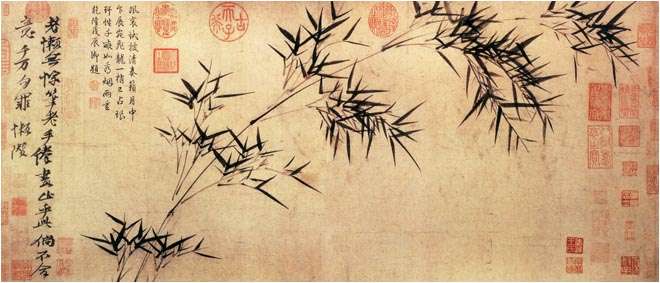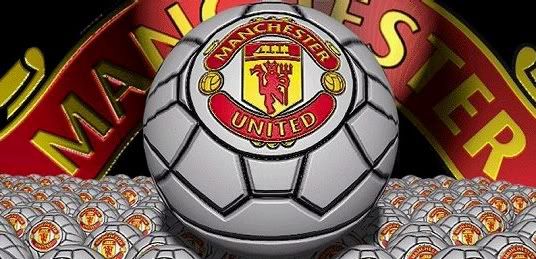講完電視講電話, 真正第一代手提無線電話, 19 世紀發明:
http://en.wikipedia.org/wiki/Nathan_Stubblefield
Inventions
Bob Lochte (2001) has argued that when Stubblefield spoke of "wireless" telephony in the 1880s he merely meant his acoustic telephone, which could operate with string. However, in the 1880s, Scientific American had already carried articles describing attempts at wireless telephony and telegraphy experiments by induction systems of Trowbridge, Preece, Phelps, and Edison, not using high frequency radio waves, so Stubblefield was likely familiar with all the principles needed to operate wireless telephony by induction in the 1880s. He made private demonstrations of wireless telephony in 1892. Rainey T. Wells was one of the first persons to hear Stubblefield's wireless voice transmissions, in that year. Wireless telegraphy using damped high frequency radio waves was demonstrated in 1894 by Sir Oliver Lodge, but that system could not carry voice messages or music. In 1898, Stubblefield was issued U.S. Patent 600457 for an "Electric battery," which was an electrolytic coil of iron and insulated copper wire to be immersed in liquid or buried in the ground, where it could also serve as a ground terminal for wireless telephony.
http://www.nathanstubblefield.com/contents.html
Wireless in 19th Century America - Beginning with Morse's 1842 experiments, American inventors including Bell and Edison confront the challenge of wireless telegraphy and telephony with limited success. By 1891, most of them have abandoned their efforts.
"Hello, Rainey." - In 1892, ignorant of the wireless inventions of the past 60 years, Nathan creates an electromagnetic induction wireless telephone and demonstrates it to his friend Rainey Wells. A few years later, Nathan develops a superior wireless telephone that uses natural conduction through the earth and water.
The Wireless Telephone Company of America - After a well-publicized public demonstration of his wireless telephone on New Years Day 1902 in Murray, including its broadcasting capabilities, Nathan's work attracts national attention. He follows this event with a demonstration in Washington DC, where he makes a ship to shore telephone call, and eventually accepts an offer of cash and stock to sell his invention to the Wireless Telephone Company of America. The company sends Nathan and his eldest son Bernard to Philadelphia and then New York to demonstrate the system for wealthy potential investors. The first presentation is successful, but the New York demonstration is a failure. Nathan returns to Murray to expose the company as a fraudulent stock promotion scheme.
...

Ada Mae, Pattie, and Nathan Stubblefield (l. to r.) with portable wireless telephone receiver, 1907
http://earlyradiohistory.us/1902stb.htm
Scientific American, May 24, 1902, page 363:
THE LATEST ADVANCE IN WIRELESS TELEPHONY.
BY WALDON FAWCETT.
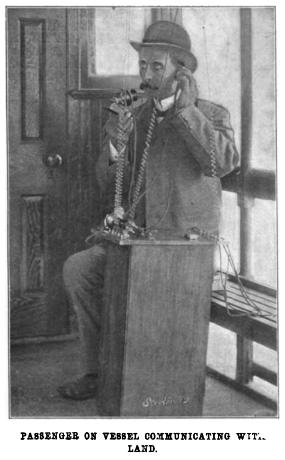
The latest and one of the most interesting systems of wireless communication with which experiments have recently been conducted is the invention of Nathan Stubblefield, of Murray, Ky., an electrical engineer who is the patentee of a number of devices both in this country and abroad. The Stubblefield system differs from that originated by Marconi in that utilization is made of the electrical currents of the earth instead of the ethereal waves employed by the Italian inventor, and which, by the way, it is now claimed, are less powerful and more susceptible to derangement by electrical disturbances than the currents found in the earth and water. In this new system, however, as in that formulated by Marconi, a series of vibrations is created, and what is known as the Hertzian electrical wave currents are used.
The key to the methods which form the basis of all the systems of wireless telephony recently discovered--the fundamental principles of wireless telephony, as it were--was discovered at Cambridge, Mass., in 1877 by Prof. Alexander Graham Bell, the inventor of the telephone system which bears his name. On the occasion mentioned Prof. Bell was experimenting to ascertain how slight a ground connection could be had with the telephone. Two pokers had been driven into the ground about fifty feet apart, and to these were attached two wires leading to an ordinary telephone receiver. Upon placing his ear to the receiver, Prof. Bell was surprised to hear quite distinctly the ticking of a clock, which after a time he was able to identify, by reason of certain peculiarities in the ticking, as that of the electrical timepiece at Cambridge University, the ground wire of which penetrated the earth at a point more than half a mile distant.
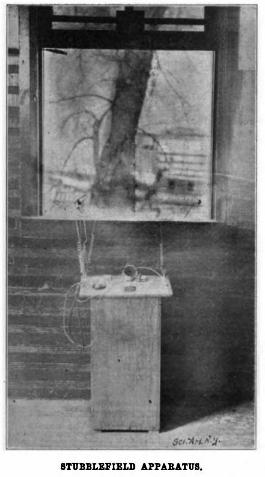
Some five years later Prof. Bell made rather extensive experiments along this same line of investigation at points on the Potomac River near Washington, but these tests were far from satisfactory. It was found on this occasion that musical sounds transmitted by the use of a "buzzer" could be heard distinctly four miles distant, but little success was attained in the matter of communicating the sound of the human voice. Meanwhile Sir William Preece, of England, had undertaken experimental study of the subject of wireless telephony, and during an interval when cable communication between the Isle of Wight and the mainland was suspended, succeeded in transmitting wireless messages to Queen Victoria at Osborne by means of the earth and water electrical currents.
Mr. Stubblefield's experiments with wireless telephony dated from his invention of an earth cell several years ago. This cell derived sufficient electrical energy from the ground in the vicinity of the spot where it was buried to run a small motor continuously for two months and six days without any attention whatever.
Indeed, the electrical current was powerful enough to run a clock and several small pieces of machinery and to ring a large gong. Mr. Stubblefield's first crude experiments looking to actual wireless transmission of the sound of the human voice were made without ground wires. Nevertheless, by means of a cumbersome and incomplete machine, without an equipment of wires of any description, messages were transmitted through a brick wall and several walls of lath and plaster. As the development of the system progressed, the present method of grounding the wires was adopted, in order to insure greater power in transmission.
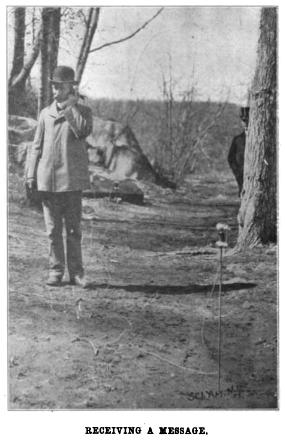
The apparatus which has been used in the most recent demonstrations of the Stubblefield system, and which will be installed by the Gordon Telephone Company, of Charleston, S. C., for the establishment of telephonic communication between the city of Charleston and the sea islands lying off the coast of South Carolina, consists primarily of an ordinary receiver and transmitter and a pair of steel rods with bell-shaped attachments which are driven into the ground to a depth of several feet at any desired point, and which are connected by twenty or thirty feet of wire to the electrical apparatus proper. This latter consists of dry cells, a generator and an induction coil, and the apparatus used in most of the experiments thus far made has been incased in a box twelve inches in length, eight inches wide and eighteen inches in height. This apparatus has demonstrated the capability of sending out a gong signal as well as transmitting voice messages, and this is, of course, of great importance in facilitating the opening of communication.
The most interesting tests of the Stubblefield system have been made on the Potomac River near Washington. During the land tests complete sentences, figures, and music were heard at a distance of several hundred yards, and conversation was as distinct as by the ordinary wire telephone. Persons, each carrying a receiver and transmitter with two steel rods, walking about at some distance from the stationary station were enabled to instantly open communication by thrusting the rods into the ground at any point. An even more remarkable test resulted in the maintenance of communication between a station on shore and a steamer anchored several hundred feet from shore. Communication between the steamer and shore was opened by dropping the wires from the apparatus on board the vessel into the water at the stern of the boat. The sounds of a harmonica played on shore were distinctly heard in the three receivers attached to the apparatus on the steamer, and singing, the sound of the human voice counting numerals, and ordinary conversation were audible. In the first tests it was found that conversation was not always distinct, but this defect was remedied by the introduction of more powerful batteries. A very interesting feature brought out during the tests mentioned was found in the capability of this form of apparatus to send simultaneous messages from a central distributing station over a very wide territory.
Extensive experiments in wireless telephony have also been made by Prof. A. Frederick Collins, an electrical engineer of Philadelphia, whose system differs only in minor details from that introduced by Mr. Stubblefield. In the Collins system, instead of utilizing steel rods, small zinc-wire screens are buried in the earth, one at the sending and another at the receiving station. A single wire connects the screen with the transmitting and receiving apparatus, mounted on a tripod immediately over the shallow hole in which the screen is stationed. With the Collins system communication has been maintained between various parts of a large modern office building, and messages have been transmitted without wires across the Delaware River at Philadelphia, a distance of over a mile.
http://earlyradiohistory.us/1902ken.htm
The Atlanta Constitution, March 9, 1902, page A6:
Kentucky Inventor Solves Problem of Wireless Telephony
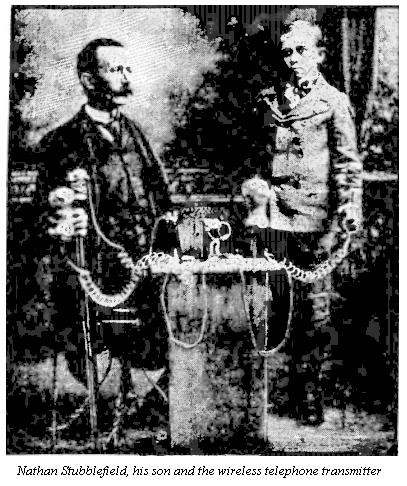
(Written for The Sunny South.)THROUGH wood, brick, mortar and solid stone; through blocks of business houses, over long distance, through city streets, uninterrupted by the noise of traffic, Nathan Stubblefield, an inventor of Murray, Ky., has transmitted the sound of human voice without wires. He has devised a system of wireless telephony. The story of how he spent his New Year's day in astounding the citizens of the little western Kentucky town will be world history before many weeks. From a station in the law office of a friend over a transmitter of his own invention he gave his friends a New Year's greeting by wireless telephony, and at seven stations, located in different business houses and offices in the town, the message was simultaneously delivered. Music, songs, whispered conversations could be heard with perfect ease. Hundreds of people visited the different receivers during the period of the public demonstration and were astonished at the result. As insidious and penetrating as the wonderful X-ray, stopping for no material object, "the electric envelope of the earth" bore the Stubblefield messages. This mysterious, intangible envelope is what Stubblefield claims to have made a messenger boy for the millions that inhabit the globe.
Nathan Stubblefield, the inventor, is, according to his own description, a "practical farmer, fruit grower and electrician." He owns valuable farming property in the vicinity of Murray and it is here that his experiments have been carried on. He is 42 years of age and is plain and unassuming in his manner. He is the inventor of several electrical contrivances which have been patented in this country and Europe. His only assistant in the work on invention has been his 14-year-old son, Bernard B. Stubblefield. The father has for years been an enthusiast on the subject of electricity and the boy has made playthings of electrical devices since babyhood. His father claims that he should have the credit for numerous valuable suggestions given in the course of working up the details of the invention.
The nature of the apparatus used by the inventor is not known. He positively declines at this time to give out either technical descriptions or diagrams of the vital part of his apparatus. All that is exposed to view while his apparatus is in working order is the ordinary commercial telephone transmitter and receiver. Within a brightly polished box, which is not opened in public, the inventor conceals his secret which he says he will not disclose until it is perfected to the smallest detail. Up to this time he has devoted his entire attention to the construction of a transmitter. He will now occupy himself with the completion of an improved receiver which has been partially constructed. It will, when perfected, bring up the sounds to any desired pitch.
In speaking of his invention, Mr. Stubblefield said:
"I know that I have solved the problem of wireless telephony, and I will now devote myself to perfecting my apparatus. I want it to be perfect when given to the public, and it is my desire that it shall not appear with defects for the scientific journals to pick to pieces, my device it will be possible to communicate with hundreds of homes at the same time. A single message can be sent from a central station to all parts of the United States. I am confident that it will operate over long distances and even at great distances the transmitter will be no bulky instrument but quite small and convenient to handle. I think that my devices would be invaluable in the matter of sending out the United States weather bureau predictions, in directing the movements of a fleet at sea and in numerous ways which appeal to one at first thought. I am in hopes of getting a government appropriation to aid me in carrying on my work, or at least the promise of its adoption when perfected. The possibilities of the invention seen to be practically unlimited, and it will be no more than a matter of time when conversation over long distances between the great cities at the country will be carried on daily without wires. I intend to continue at work on my device and think that I will get other startling results in a short time." Stubblefield does not intimate at what time he will give out the diagrams of his apparatus. His workshop is in his home, which is located on a farm several miles from Murray and all of his preliminary experiments have been carried on with great secrecy on account of the comparative isolation of the place. He is quite as proud of the part which his boy has played in working on his apparatus as he is of the success of his public exhibition. He speaks entertainingly on the question of his invention and its possibilities.
Professor M. L. Pence, who has the chair of physics at the Kentucky State college, and whose theory as to why the earth is a magnet created a sensation in the scientific world some months ago, was seen in regard to the Stubblefield experiments, which seem to have a bearing on his theory. He said:
"I certainly regard wireless telephony as possible just as much so as wireless telegraphy. In ordinary telephony no sound passes over the wire. Nothing but electric energy is transmitted. Now, instead of using a wire, the ether may be used, and the energy may be transmitted in the form of ether waves. The ether is the great vehicle for the transmission of energy. This medium fills all space, interplanetary and intermolecular. I further believe that this same ether is electricity and that all the electrical phenomena are due to the same disturbance of the ether. The ether is easily thrown into vibration, resulting in ether waves. There is an immense variety of these waves ranging from those whose lengths are only a few millionths of an inch to those whose lengths are hundreds of miles. Some of these waves affect the eye and are called light waves; some transmit heat energy. They are all electro-magnetic waves and all travel with immense velocity.
"The manner in which these waves transmit energy may be illustrated in this way: suppose the pebbles on the shore of a pond of water are set in motion. This motion will disturb the water, cause waves to run across the pond, and, striking the pebbles on the farther shore, will put them in motion, the effect thus being like the cause. In a similar way the intermolecular vibration of the sun is transmitted to the earth through the agency of other waves and causes intermolecular vibration here. Now, we have this same principle in wireless telegraphy. At the transmitting station an electric current is made to oscillate under very high voltage or pressure, across a spark gap and with enormous frequency of vibration. The ether is violently disturbed at this gap and waves go out in every direction. These waves striking an electric circuit at a distant station, will set up oscillations in it similar to the oscillations which produced the waves. A telephone receiver will respond to these secondary vibrations, and so far we have wireless telephony. The principal thing at present, I think, is to devise a transmitter which can be operated by the voice. I do not know fully just what Stubblefield has accomplished, but the probabilities are that someone will develop a system of wireless telephony that can be used for practical purposes." Electricians here in discussing the problem go further into the matter than Stubblefield has for publication and say that as in wireless telegraphy, the receiving and sending instruments will probably have to be tuned electrically to one another and that by this means a wireless telephone communication might be had without fear of other people tapping the wireless line. Stubblefield thinks, that a transmitter for long distance will not have to be of large size, and in that event European and American houses, with properly tuned instruments, could hold daily conversations over wireless instruments no more cumbersome to the office than the first long distance telephone boxes. |
